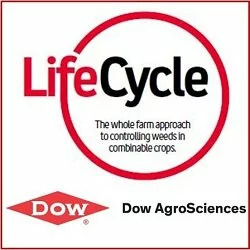A Surprising Year
All in all things have gone fairly smoothly over the last few weeks. We finished the wheat harvest successfully in the dry period around the end of August. Worries about completing the OSR planting behind winter wheat were allayed when we got that all finished in the first 10 days of September with the one pass Bio drill. All 179ha is up and looking fantastic. We had to wait another three weeks for the spring rape to ripen but we then managed to pick it off on the dry days amongst the showers at the end of September. We don’t like spring rape for that reason but last year had no choice when the winter rape failed and in fact were reasonably happy with yields of 2.34T per ha.
It has been a dry time through most of our cultivations and we have established some good seed beds. We always try to be patient with the drilling to combat black grass and other weed problems and aim to hold off drilling the 1st wheats until 25 September and the 2nd wheats until 10 October to ensure we get sterile seed beds. A warm autumn has been good for weeds and we were able to spray them off before drilling so patience seems to have paid off this year with a good start for the crops.
Last week we were fully into maize harvest for four days, tying up all the tractors, so we couldn’t get on with anything else. As the forage maize is part of the arable rotation and that land goes into 1st wheat we have quite a big workload to get the ploughing and drilling done just after maize harvest and it was a bit disheartening that we didn’t get finished before the rain came. We have almost 100 ha still to drill. Our main drill is a 6m Simba Horsch Sprinter but we keep a power harrow drill for wet conditions, especially on the Pewsey Vale clay, and go straight in on top of the plough with that so that is on its way out to start work now.
It is currently too wet for rolling but the seeds beds still look about average and we are hopeful that they will do. Of course there is a slight disadvantage in not getting the pre-em herbicides on and if it doesn’t come dry enough to go on with the roller, we may have to wait to go post-emergence. The weather might improve of course and we shall keep going with planting if we can as we really don’t like spring cropping, except the maize, if we can avoid it. We have a total of over 430ha of wheat (including the share farm) to get in so that is a fair acreage and therefore it’s perhaps not surprising that we are still drilling! In fact some of our best winter wheats have been 1st wheats after maize, drilled late, so we are not too worried at the moment though another week of fine weather would have been welcome.
The maize harvest went really well and looks to have yielded well too. The clamp is certainly fuller than ever, partly because, due to crop failures last year, we drilled an extra 10 ha of maize. We thought we had sold that off the field but no one wanted it as everyone’s maize crops have been good, so we clamped it instead. We are still deliberating about the acreage for next year – we may reduce it, but exciting news is that we have planning permission for our new dairy development, which will mean a larger herd in the next year to 18 months so a bit of extra feed stock won’t worry us this year. More of that another time.
Looking at our cropping plan varieties are not changing much for the coming season. In OSR we have drilled DK Camelot, which is still a good variety, and an increased area of Pioneer PR46W21 because we were impressed with that this year (4.1T per ha), as well as a bit of Vision, because we like it. It is a good performer and always yields well (3.7T on light land last year). Only two winter OSR crops survived last year and those were PR46 and Vision.
All the early planted 1st winter wheat, after OSR and any fallow land, has gone into Diego. We have drilled some Oakley on the lighter land as this has proved to be a phenomenal variety for us, yielding 11.2T per ha. It outperformed the other three varieties by more than half a tonne and that was also above the five year average. Yellow rust can be a big issue and the agronomist doesn’t like us to grow too much of it so we do limit the area. We are growing Santiago after the maize. Last year it yielded an average of 10.7T per ha off 54ha so that is also a great performer.
Almost all of the 2nd wheat is Solstice though we have tried one field of Crusoe for the first time, as a possible replacement for Solstice next year, if it does well. Last year the Solstice went into very wet seed beds and still gave us 8.7T per ha whilst Diego as a 1st wheat did 9.4T per ha. It was only the second year we have grown it so we don’t have a clear view of that yet. We usually work with variable N applications and seed rates when we think it appropriate on different soils and crop conditions but last spring the crops looked so poor that we decided on a standard basic approach thinking that anything that came from it would be a bonus. However, we obviously had the weather to fill the heads and give a good yield. Straw yields have been phenomenal this year too so we have taken 4,700 large round bales off the farm compared to our target of 4,000 and last year’s 3,700 with bought in straw as well. Overall the winter wheat averaged 9.6T per ha so, considering how it looked in the spring, we are very, very pleased with that. It may have gone into dodgy ground but something seemed to work out in the end. A lot of winter rape failed and some of that went into spring rape and maize and some was left fallow. We managed to get all our acreage of wheat in though some of the later planted wheat on a share farm failed and we decided to leave that fallow to allow for early drilling of 1st wheats this year. We were down slightly on area but everything that was in did well.
Overall it has been quite a surprising year!







 Saving...
Saving...
Add a comment
You must be logged in to post a comment.